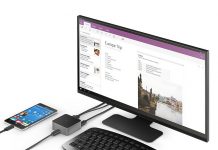
Hopefully you don’t need a Famous Author to validate your purchasing decisions, so I’m not posting about Neil Gaiman’s opinions on the Kindle just to make you feel better/worse about your new ereader. Instead, I thought it might provide some useful things to think about when you shop for your next device, or when you buy ebooks in the years to come.
The Kindle, he writes in a forthcoming article for Locus magazine, “wins” over print in two areas. First, it’s easier to read than a printed book if you need larger sized text, because it can make any book a large-print edition without requiring any real knowledge of how the device works; this is both a crucial feature and usability requirement for the current 40-and-over set. Second, its “buy once, read anywhere” approach makes reading big books a pleasure instead of a task. (Gaiman writes that he still prefers paperbacks for smaller, pocketable books.)
That first achievement–ease of use–sounds like common sense, but it’s actually pretty hard for companies to pull off these days, which is why you should always try out an ereader in person before you buy it. In my opinion there are only a handful of truly easy-to-use consumer electronics in the world: the iPhone, the Tivo (with the original menu, not the unusable HD interface), the Keurig brewer, the Flip videocamera, and the Kindle. Although Amazon’s web interface for the Kindle is nothing to brag about, it’s possible to avoid it almost entirely and still get full use out of your Kindle.
This simplicity really hit home for me last week, when I took advantage of Borders’ “please give us some revenue” sale and bought the Kobo Wi-Fi for $100. I bought it for my mom, because I figured even though she’d miss out on cheap Kindle books, she’d be able to access library ebooks on a Kobo. But I wanted to give it a test run first to make sure it would be easy to use. I immediately fell in love with the hardware, but I kept running into problems with the usability. First, I hated how it was pre-set to connect only to the Borders ebook store and not to the general Kobobooks.com website (actually I hated that there were two shopping destinations at all–Kobo should just be Kobo). I also didn’t like how you had to navigate down through multiple screens just to toggle wireless access, when that’s the very first menu item on the Kindle. I hated that you have to install a desktop app if you want to wirelessly sync the Kobo with your library. And then there was the Adobe Digital Editions program requirement for authorizing library check-outs.
In the end, I couldn’t bring myself to send my mother an ereader that was looking suspiciously like it would require many hours of technical support. I took it back and spent the extra $40 for a Wi-Fi Kindle. She’ll never have to connect it to her aging iBook or think of it as a PC peripheral for as long as she uses it. She can buy a new book while she’s at work, or I can email her a file, and it will appear on her Kindle automatically when she gets home. Hooray for simplicity.*
 The second achievement Gaiman describes–the ability to access a book across multiple devices–isn’t unique to Kindle, and I think it’s more of a general benefit of reading ebooks, at least if you’re a Nook, Kindle, Kobo or Google eBooks customer. In fact, it’s one of the innate benefits of storing your books in the “cloud”–they’re easy to access from multiple devices, no matter where you go.
The second achievement Gaiman describes–the ability to access a book across multiple devices–isn’t unique to Kindle, and I think it’s more of a general benefit of reading ebooks, at least if you’re a Nook, Kindle, Kobo or Google eBooks customer. In fact, it’s one of the innate benefits of storing your books in the “cloud”–they’re easy to access from multiple devices, no matter where you go.
But in theory, at least, cloud storage has a heavy potential cost you should be aware of, which is that it forces consumers to give up control over their purchases.
Publishers would love to see the cloud become the only way to sell ebook licenses to readers, because they could finally get rid of unprofitable consumer behavior like passing books along to friends or shifting formats–the kinds of privileges that consumers demand when they feel like they “own” something, but that are easier to kill off when a customer grows comfortable with simply paying for access to the cloud. Cloud access also makes it easier for publishers to enforce their interpretations of fair use, and to block any applications of technology that they haven’t yet monetized.
For that reason, even though I share Gaiman’s pleasure at being able to pick up my reading where I left off as I move among devices, I always download and save backup copies of my ebooks. That way I will have at least a fighting chance of preserving access to them in the future, no matter what the publisher or retailer decides.
The bad news is, the type of consumer who takes care to make backup copies of ebook purchases probably isn’t the same one who needs an easy-to-use device, so I fear the cloud approach will win out in the years to come. The good news is that the topic is moot right now, because today all the major ereader stores let you download copies of your purchases. But as long as we still have a choice, I suggest that you patronize retailers and publishers who offer file downloads as well as cloud storage.
This isn’t just a pro-Kindle post. I would have happily bought my mom a Nook Color instead of a Kindle had it been in my budget. I wouldn’t have bought an original Nook, though, because I find its interface too clunky. (Return to the post.)
(Neil Gaiman photo: Jutta @ flickr; cloud image: akakumo)
Via Chris Walters’ BookSprung blog






























This piece is an excellent example of real world consumer feedback and raises some noteworthy points. I hope that a good portion of eBook purveyors are paying attention.
So why should I care what Neil Gaiman thinks about the Kindle? Or that Chris Walters decided being cheap (buying the Kobo) wasn’t necessarily the best idea?
I notice that Walters focused not on how good a reading device the Kobo would be for his mother but on whether he might have to give an hour or two of tech support. I think the Kindle was a better choice but not because wireless access was better placed in the navigation menu, but because the Pearl screen provides a signifcantly better reading experience, which is, presumably, what his mother intends to do with the device.
I continue to be concerned about how device buyers make their buying decision. It is not that, for example, wireless is unimportant — it can be very important. But what is the primary purpose of buying a dedicated ebook device? It is to read ebooks. To my mind the sharpness of the screen and the device’s comfort when being held for a long period of time should weigh signifcantly more in the buying decision than whether, for example, adding books is is via wireless or side loading. These other factors need to be considered, but should not be the primary focus of reviews and decisions.
Viewed from theat perspective, I don’t see why I should care — based on this article — about either Gaiman’s or Walter’s love of the Kindle.